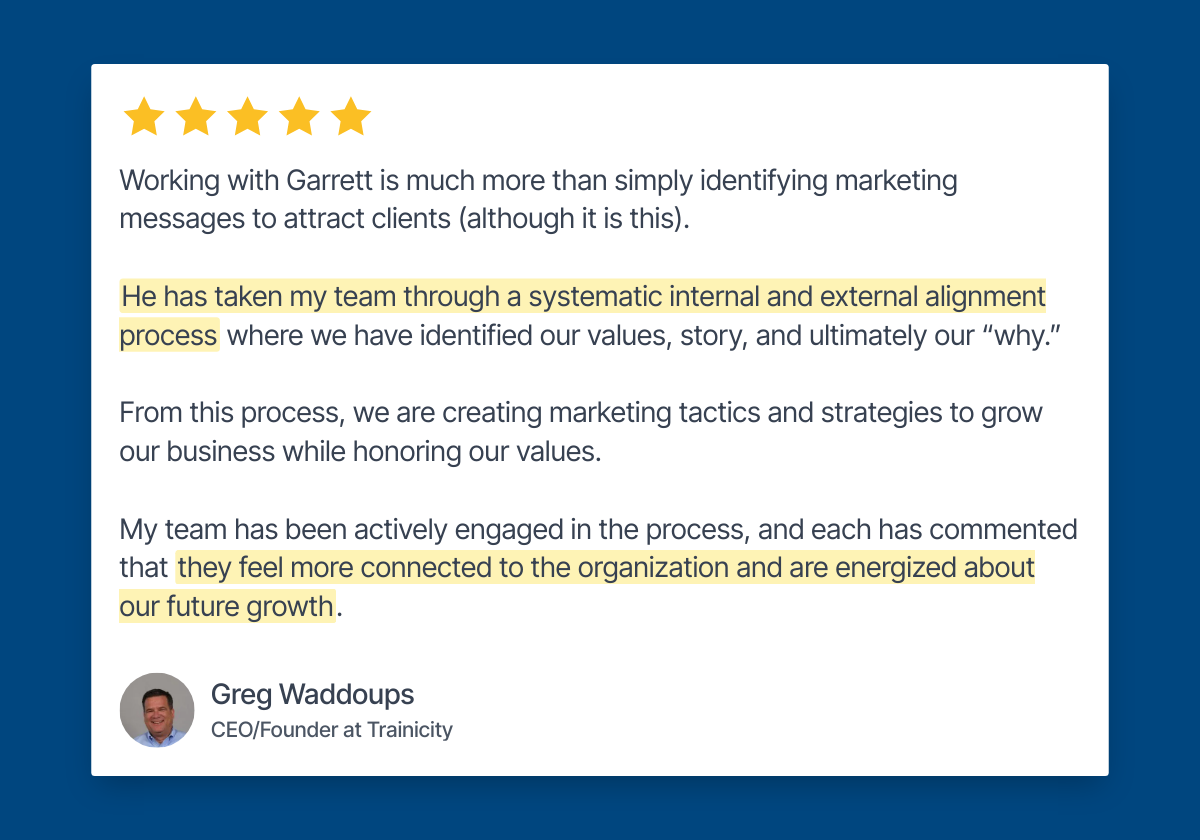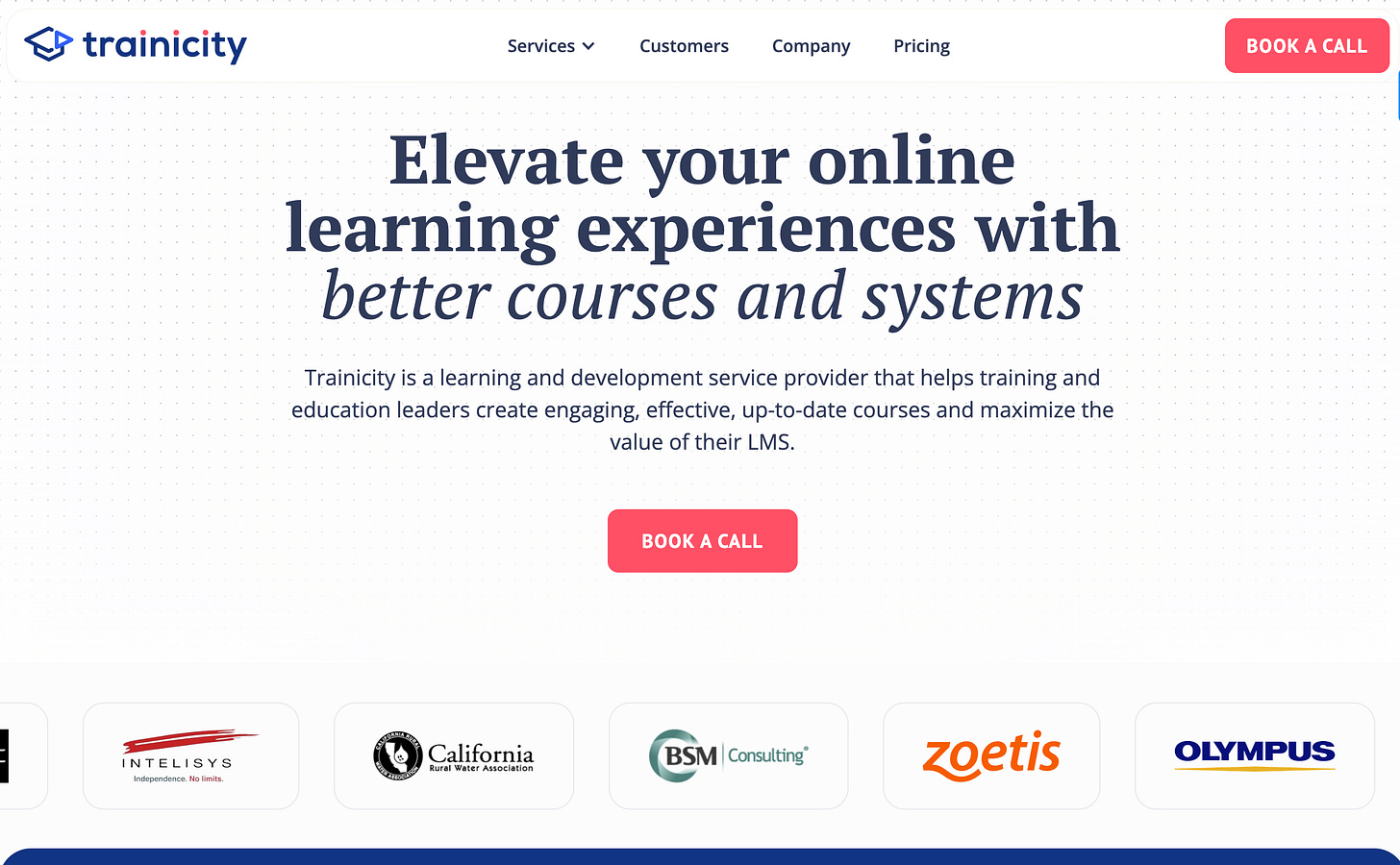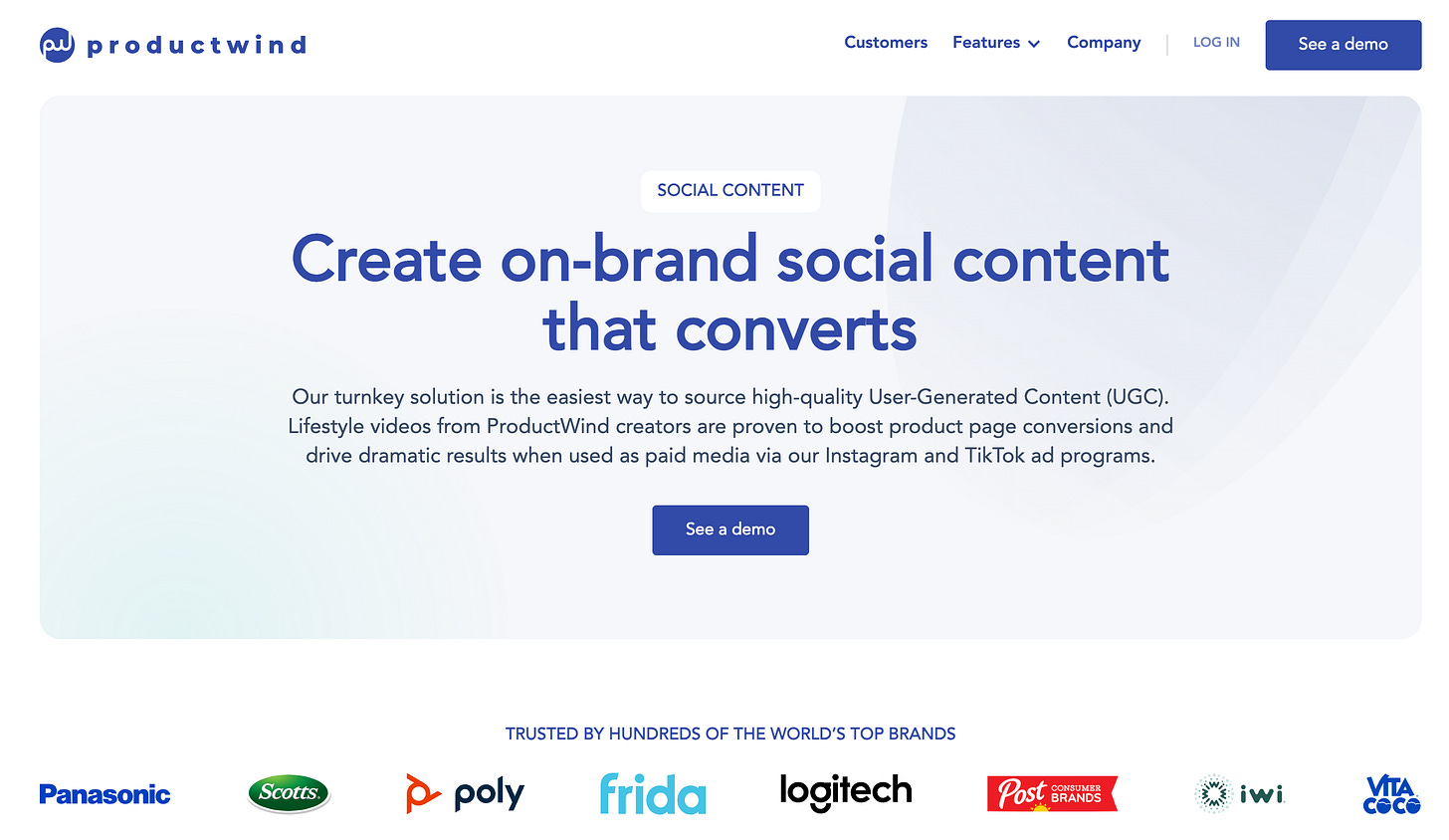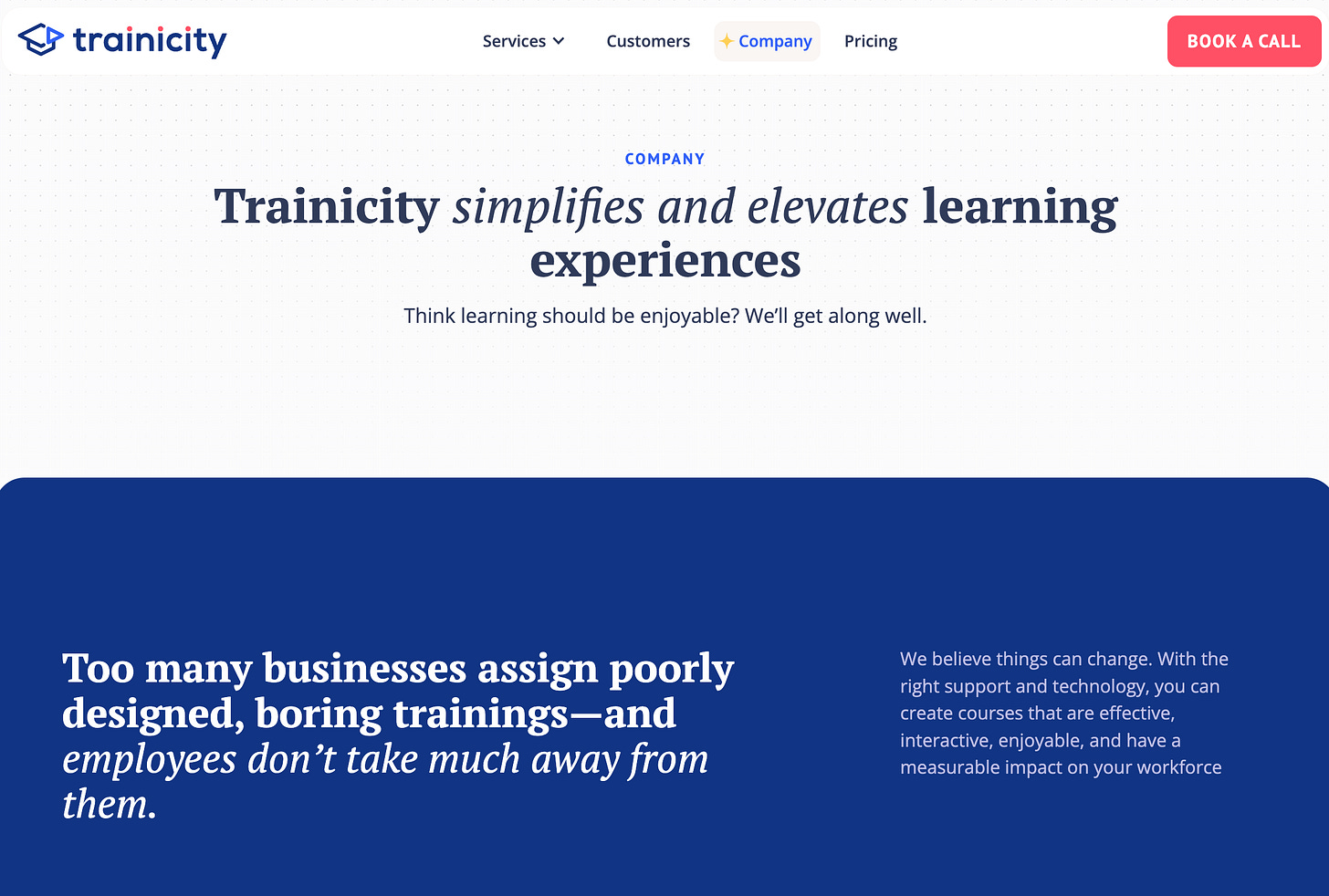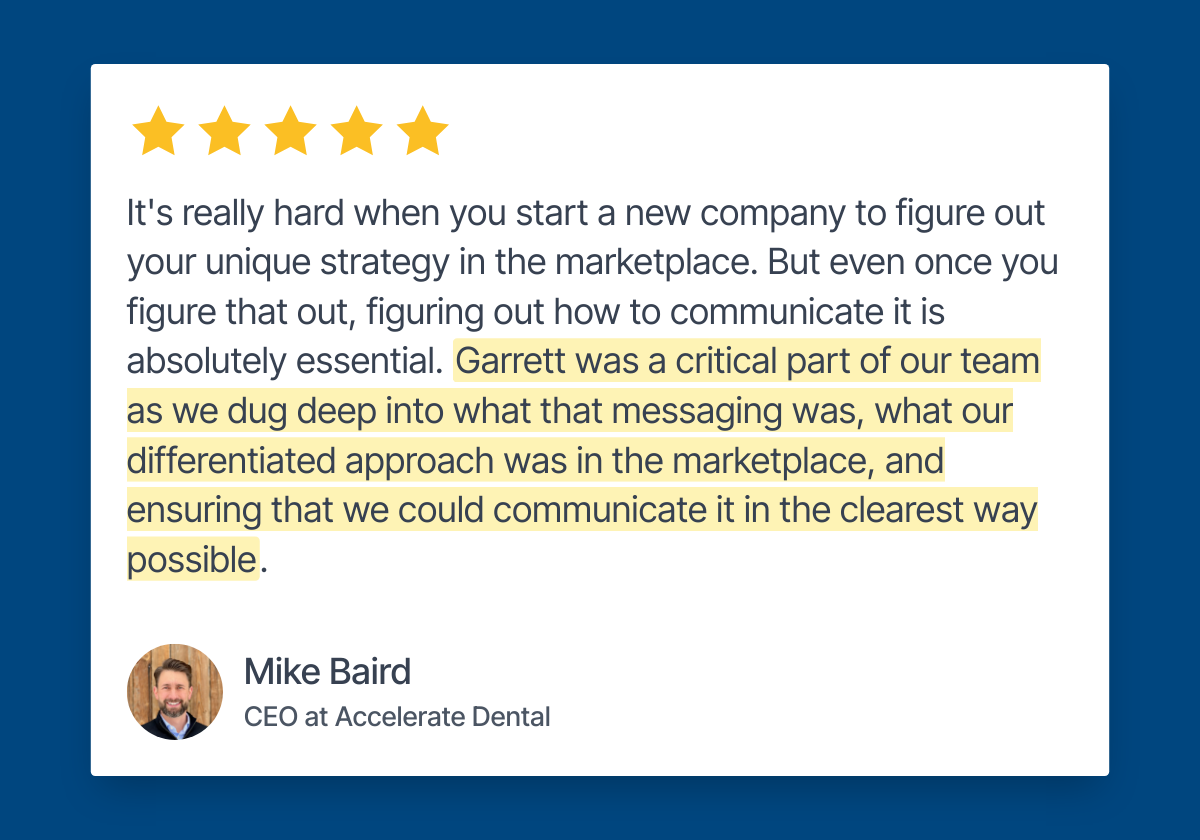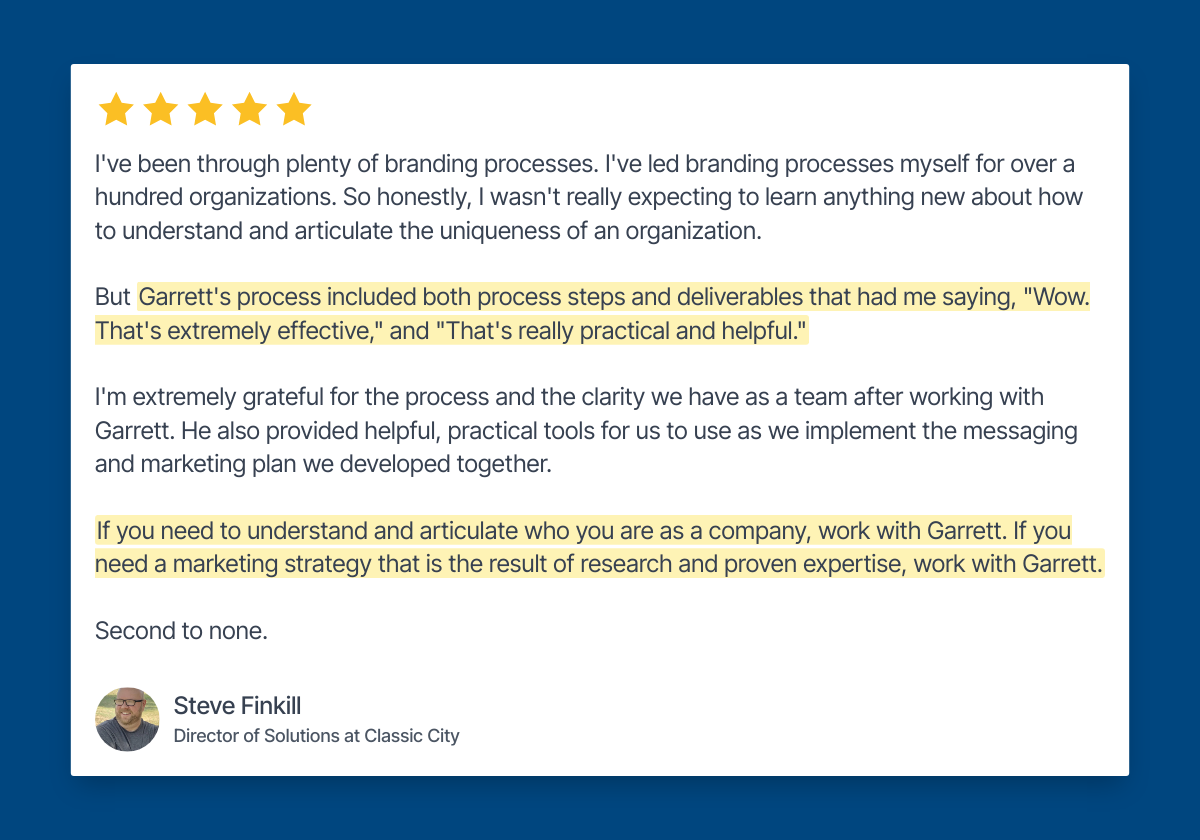The Guide to Running a Website Messaging Workshop for Startups
In this guide, I share the exact process I use with my clients to create website messaging that resonates with your best-fit customers, drives growth, and aligns your entire go-to-market team.
As a startup founder or marketer, you know the importance of clear, compelling messaging on your website. But crafting that message and getting your entire team aligned? That's where things get tricky.
That's why I've developed the website messaging workshop—a powerful process that I've seen drive remarkable results for startups like yours.
In this guide, I'll walk you through running your own website messaging workshop. I'll share the exact process I use with my clients to create website messaging that resonates with your best-fit customers, drives growth, and aligns your entire go-to-market team.
Why Run a Website Messaging Workshop?
Before we dive into the 'how,' let's talk about the 'why.' Through my work with B2B startups, I've seen a well-executed messaging workshop achieve four key things:
Clarify Your Value Proposition: It helps you cut through the noise in the crowded B2B landscape.
Align Your Team: It gets everyone on the same page, from marketing to sales to product development.
Accelerate Growth: Clear messaging can shorten sales cycles and improve conversion rates.
Transform Your Website: It turns your website into a powerful sales tool that communicates your value effectively.
Don't just take my word for it. Here's what Greg Waddoups, CEO/Founder at Trainicity, had to say after going through this process with me:
Sample Timeline for the Messaging Process
To help you plan your website messaging overhaul, here's a sample timeline of the entire process that I typically use with my clients:
Week 1-2: Pre-Workshop Preparation
Identify best-fit customers
Create and send customer surveys or do interviews
Create and send employee survey
Analyze survey/interview results
Schedule workshop sessions
Week 3: Conduct Workshop Sessions
Session 1: Market Context Workshop (2 hours)
Session 2: Positioning Workshop (2 hours)
Session 3: Brand Workshop (2 hours)
Week 4: Create Messaging Architecture
Compile workshop insights
Draft Messaging Architecture document
Review and refine with key stakeholders
Week 5: Website Copy Creation and Review
Create draft website copy based on Messaging Architecture
Share in Google Docs for team review and feedback
Refine copy based on feedback
Week 6+: Begin Website Implementation
Update the website with new messaging
Conduct final review and make any necessary adjustments
You can adjust this timeline based on your team's availability and the complexity of your offerings.
Now, let's get into the nitty-gritty of running your own website messaging workshop.
Step 1: Pre-Workshop Preparation
The success of your workshop largely depends on the groundwork you lay beforehand. Here's what I recommend:
Identify Your Best-Fit Customers: Before the workshop, align with your team on your best customers. They usually buy quickly, pay full price, love your product/service, are good partners to work with, and stick around and refer others. These customers will guide all aspects of your messaging.
Need help with this? Check out my guides for How to develop your startup's ideal customer profile (ICP) and How to develop your startup's buyer personas and journey maps
Conduct Customer Surveys or Interviews: Send out short surveys or set a time to interview 5-6 of your best-fit customers. These insights collected will provide valuable insights to inform your messaging.
Need help? Check out my guide for How to Run Jobs-to-be-Done Interviews with Customers
Conduct Employee Surveys: Send short surveys to your go-to-market team. This can be an excellent way to check existing team messaging alignment and help team members prepare for the workshop.
Download your own copies of my Buyer Journey Interview Template and Employee Survey Template
Analyze Survey/Interview Results: Review the responses and look for patterns. What pain points do customers consistently mention? How do they describe your value? Where are there discrepancies between customer and employee perceptions?
Schedule the Workshop: Plan for a 4-8 hour session, typically split into multiple 2-hour sessions. Ensure all key stakeholders from your go-to-market team can attend.
Prepare Materials: Gather relevant data, competitor information, and any existing messaging documents.
Step 2: Running the Workshop
Now for the main event. Here's how I structure website messaging workshops:
Market Context Workshop (~2 hours)
Discuss Market Insight: Your point of view about the customer's situation, problems, and solutions in the market.
Define Old vs. New Game: Name and describe your buyers' new and old ways of doing things.
Identify Life-and-Death Stakes: Convey life-and-death stakes (winners are playing, losers are not). Describe success vs. failure.
Describe The Perfect World: A description of the characteristics of the perfect solution that would help buyers achieve their goals.
Outline Proof Points: Evidence that you can deliver on the value you claim. (Ex. Success stories, testimonials, awards)
Positioning Workshop (~2 hours)
Define Competitive Alternatives: What customers would use if you didn't exist. (Status quo, manual processes, competitive solutions)
Identify Unique Capabilities: The features, attributes, relationships, or expertise you have that others do not.
Craft Value Propositions: The 1-4 most common values your unique capabilities enable for customers.
Describe Best-Fit Customers: The customers who care most about that unique value. Any additional attributes to add?
Determine Category: The type of solution you provide that makes your value obvious to customers.
Outline How It Works: The steps buyers should take to realize the value you promise with your product/service.
Brand Workshop (~2 hours)
Define Company DNA: The type of DNA that drives your company. We are a (Customer, Product, Concept) driven company.
Craft Mission Statement: Your core purpose. Answers the question, "Why do we exist?"
Identify Core Values: Natural, inherent traits in the best team members. Answers the question, "How do we behave?"
Choose Brand Archetype: Your most dominant characteristic—one of twelve genres assigned to your brand based on symbolism.
Determine the Brand Driver: The single, most crucial core concept around which the brand (the emotional side of the company) is built.
Describe Brand Personality: The human characteristics of your brand. Reflects how you sound and want to be experienced.
Remember, these times are flexible. I always adjust based on the team's dynamics and the complexity of the offerings.
Download your own copy of my Messaging Workshop Template
Note: You may not need to include every messaging element above. These are the ones I’ve found most helpful but I often adjust based on the needs of the company I’m working with. For example, maybe there isn’t a clear “new/old game,” or maybe a startup needs a vision statement to help further clarify its mission statement.
Tools for Facilitating the Workshop
For both in-person and remote workshops, I recommend using a combination of simple, widely available tools:
Zoom for video conferencing (for remote workshops)
Google Docs for collaborative writing and feedback
Google Slides for presenting and brainstorming
Google Forms for surveys and collecting input
Grain.com for recording and transcribing customer interviews
Senja.io for collecting, managing, and sharing customer testimonials on your website
These tools are user-friendly, easily accessible, and provide the necessary functionality for a successful workshop and implementation.
Step 3: Creating Your Messaging Architecture
After the workshop, I help teams compile all the insights and decisions into a Messaging Architecture document. This serves as your north star for all future communications, especially your website.
Download your own copy of my Messaging Architecture Template
Your Messaging Architecture should include:
Market Context
Audience (ICP & Buyer Persona)
Market Context
Old vs. New Game
Current Ways & Problems
The Perfect World
Positioning
Category
Main Capability
How it Works
Value Propositions
Capabilities / Features (Call out those which are unique compared to alternatives.)
Benefit Descriptions
Proof
Brand
Mission
Core Values
Company DNA
Brand Archetype
Brand Driver
Personality Traits
Boilerplate Messaging
One-Liner
One-Paragraph Elevator Pitch
Multi-Paragraph
Step 4: Implementing Your New Messaging on Your Website
With your Messaging Architecture in hand, it's time to update your website. Here's how I recommend mapping different components of your Messaging Architecture to your website, along with examples from a few clients I’ve worked with:
Homepage:
Headline: The ICP's main goal expressed as a benefit. Answers: “Now you can…?” Use your main capability
Subheadline: Include your one-liner boilerplate description
First Section: Incorporate your market insight, old vs. new game, or life and death stakes
Value Propositions: Feature your top 3-4 value propositions with supporting capabilities/features
How It Works: Outline the steps from your Messaging Architecture
Social Proof: Include logos of your best-fit customers and relevant testimonials
Product/Service Pages:
Use your value propositions as section headers
Describe features and capabilities that support each value proposition
Include use cases specific to your best-fit customers
About Us Page:
Mission Statement: Feature prominently
Core Values: List and describe
Brand Story: Incorporate elements of your market context and perfect world description
Team Section: Reflect your brand personality in how you present your team
Gathering Feedback on New Website Messaging
After your workshop, gathering feedback on your new messaging is crucial before fully implementing it on your website. Here's the three-step process I recommend:
Align on Core Components: Ensure your team agrees on the critical elements of your Messaging Architecture.
Agree on Layout: Create wireframes or rough layouts for your key pages, showing where different messaging components will appear.
Review Website Copy: Put your draft website copy into a Google Doc, organized by page and section. Share this with your team and key stakeholders, allowing them to comment and suggest edits directly in the document.
Download your own copies of my Website Wireframe Example Template and Website Copy Updates Template
This process allows for collaborative refinement of your messaging, ensuring it accurately reflects your workshop outcomes and resonates with your team before implementation.
In addition to gathering feedback from your team, it's also valuable to share it with a few trusted best-fit customers to get their input.
A messaging testing tool like Wynter can also be valuable if you have a budget and want to go one step further. Just be sure that if you use a tool like this, your audience selected is as similar to your best-fit customers as possible.
The Impact of a Well-Executed Messaging Workshop
I've seen firsthand how transformative a good messaging workshop can be. Here's what Mike Baird, CEO at Accelerate Dental, shared about his experience working with me:
Common Pitfalls and How to Avoid Them
In my years of running these workshops, I've noticed some common challenges. Here's how to avoid them:
Lack of Preparation: Ensure you've done thorough research and gathered insights before the workshop.
Ignoring Customer Perspectives: Always bring the conversation back to your customers' needs and perspectives.
Getting Stuck in the Details: Focus on the big picture during the workshop. You can refine specifics later.
Failing to Follow Through: The workshop is just the beginning. The key is to consistently apply your new messaging across your website and other channels.
To avoid these pitfalls, stay focused on your goals, involve the right people, and be prepared to challenge long-held assumptions about your business.
Helpful Templates
To support your website messaging workshop, I've shared several templates that you might find helpful:
How to Develop Your Startup's Ideal Customer Profile (ICP) Guide
How to Develop Your Startup's Buyer Personas and Journey Maps Guide
These templates can help streamline your workshop process and ensure that you consider all crucial aspects of your messaging strategy.
Running Your Own Workshop vs. Hiring a Facilitator
While this guide provides a framework for running your own messaging workshop, some startups find value in bringing in an external facilitator like myself. A skilled facilitator can:
Provide an objective perspective
Manage group dynamics and ensure all voices are heard
Bring expertise and best practices from other B2B startups
Push your team to dig deeper and challenge assumptions
Steve Finkill, Director of Solutions at Classic City, shares his experience working with me:
Whether you choose to run the workshop yourself or bring in help, the important thing is to prioritize clear, consistent messaging on your website. In today's competitive B2B landscape, it's not just nice to have – it's essential for growth.
Ready to transform your startup's website messaging? Start planning your website messaging workshop today. Your future customers (and your team) will thank you.
Additional Resources:
For those looking to dive deeper into messaging strategy, here are some valuable resources that have inspired my workshop approach:
"Obviously Awesome" by April Dunford
"Building a Story Brand" by Donald Miller
Work by Andy Cunningham of Cunningham Collective
Strategic narrative work by Andy Raskin
These experts offer additional frameworks and insights that can complement and enhance your messaging workshop process.
If you have any questions about running your own website messaging workshop or if you'd like to explore how I could help facilitate this process for your startup, don't hesitate to reach out. I'm always happy to chat about messaging strategy and how it can drive growth for B2B startups.



